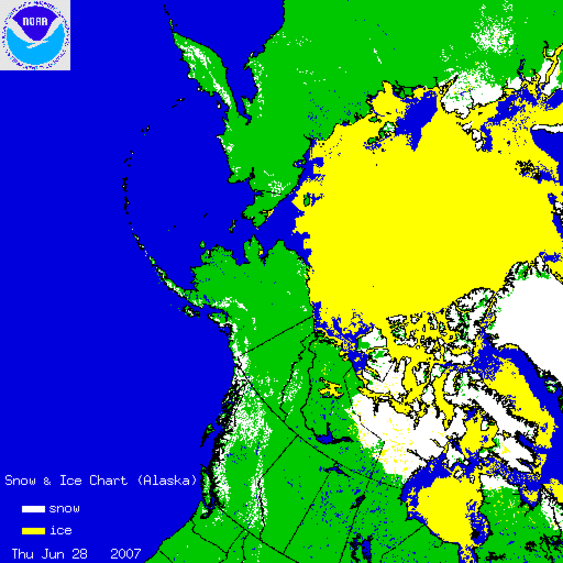
In June 2018, Arctic ice extent held up against previous years despite the Pacific basins of Bering and Okhotsk being ice-free. Now in July when ice extent typically declines, 2018 extents are essentially flat. The Arctic core is showing little change, perhaps due to increased thickness (volume) as reported by DMI. The image above shows ice extents on day 179 for years 2007 through 2018.
The graph below shows how the Arctic extent has faired from mid June to July 3 (yesterday) compared to the 11 year average and to some years of interest.
 Note that 2018 was on average and comparable to other years from Mid June on. Then recently ice extents have held steady just below 10M km2, while averages and other years declined. 2018 is now 370k km2 above the 11 year average, 535k km2 higher than 2017, and 660k km2 greater than 2007 at this date. SII 2018 was tracking the same as MASIE in June but has now dropped 360k km2 lower.
Note that 2018 was on average and comparable to other years from Mid June on. Then recently ice extents have held steady just below 10M km2, while averages and other years declined. 2018 is now 370k km2 above the 11 year average, 535k km2 higher than 2017, and 660k km2 greater than 2007 at this date. SII 2018 was tracking the same as MASIE in June but has now dropped 360k km2 lower.

The table below shows ice extents by regions comparing 2018 with 11-year average (2007 to 2017 inclusive) and 2017 as of day 179.
| Region | 2018179 | Day 179 Average |
2018-Ave. | 2007179 | 2018-2007 |
| (0) Northern_Hemisphere | 10029935 | 10054734 | -24798 | 10034293 | -4358 |
| (1) Beaufort_Sea | 1015808 | 919074 | 96734 | 948463 | 67345 |
| (2) Chukchi_Sea | 711178 | 732616 | -21437 | 680534 | 30645 |
| (3) East_Siberian_Sea | 1053171 | 1032249 | 20923 | 963850 | 89321 |
| (4) Laptev_Sea | 647574 | 745700 | -98126 | 663276 | -15702 |
| (5) Kara_Sea | 726226 | 598140 | 128086 | 665920 | 60307 |
| (6) Barents_Sea | 60948 | 134229 | -73281 | 177419 | -116471 |
| (7) Greenland_Sea | 356614 | 552157 | -195543 | 627602 | -270989 |
| (8) Baffin_Bay_Gulf_of_St._Lawrence | 714402 | 552083 | 162319 | 531706 | 182696 |
| (9) Canadian_Archipelago | 794355 | 783057 | 11298 | 775033 | 19322 |
| (10) Hudson_Bay | 900609 | 761919 | 138690 | 777550 | 123058 |
| (11) Central_Arctic | 3047677 | 3217803 | -170125 | 3216654 | -168977 |
| (12) Bering_Sea | 185 | 6350 | -6165 | 1080 | -895 |
| (13) Baltic_Sea | 0 | 4 | -4 | 0 | 0 |
| (14) Sea_of_Okhotsk | 0 | 17972 | -17972 | 3531 | -3531 |
2018 is 25k km2 below average, entirely due to Okhotsk plus Bering being ice-free. Greenland Sea and Barents are down, offset by surpluses in Beaufort, Kara, Baffin and Hudson Bays.
Footnote:
Arctic extents are shaped by the three Ws: Water, Wind and Weather. This video shows how a massive cyclone in 2012 broke up the ice, moved it around and flushed much of it out through the Fram strait.The ice has recovered since then and is now quite thick.
Reblogged this on Climate Collections and commented:
It’s all about the volume.
Extent (a fickle metric) varies widely due to winds and currents alternately packing and dispersing ice (not to mention the varying conventions as to what percent concentration of sea ice is counted among the extent).
IIRC it was 2012 when much of the thick, currents (Transpolar) carried much of the multi-year ice out of the Arctic basin into the Greenland Sea between Greenland and Svalbaard.
LikeLike